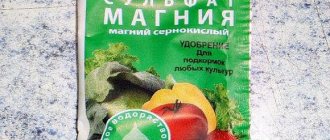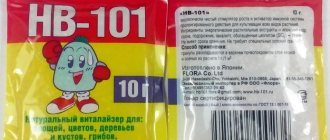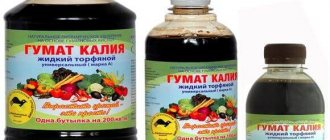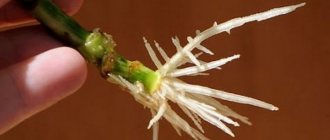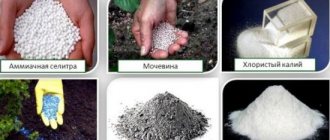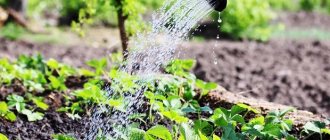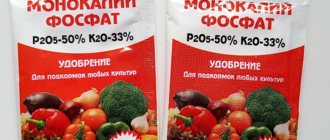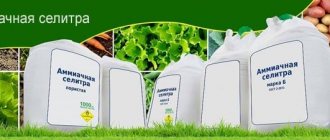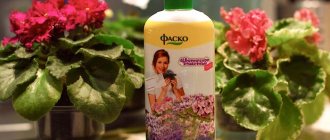In ancient times, people used the potential of the soil differently than modern farmers. The field was divided into parts and each of them was sown according to a special pattern. Nowadays, such a technology for restoring soil with minerals and vitamins is impossible for certain reasons.
This means that there is a need to use additional means: fertilizing, mineralization, and the addition of individual preparations. Potassium sulfate is a substance that is used as a fertilizer. With its help, you can replenish the necessary elements to normalize the growth and development of vegetable, berry and other crops.
Description and characteristic properties of the fertilizer
K₂SO₄ or potassium sulfate is a popular product in agriculture. The chemical formula indicates a high concentration of components that are extremely important for cultivation. These minerals are obtained from natural components:
- chenita;
- langbeinite.
Use in a country house, field, or greenhouse is allowed, as it brings benefits in open and closed ground. It looks like crystals. The color is light. Can be purchased in several forms:
- powder;
- granular;
- liquid
In all forms, the composition and chemical properties will be preserved. When purchasing potassium sulfate, agricultural technicians pay attention to the manufacturer’s instructions and instructions. The main condition for an agricultural product: the content of the main element is at least 45-50%.
Precautionary measures
Potassium sulfate is not a potent substance that is harmful to human and animal health, but you need to work with it carefully.
Rules for working with potash fertilizers:
- Wear protective gloves on your hands;
- While working with the drug, it is forbidden to smoke, drink water, or eat;
- Wear a protective mask when mixing the substance with water;
- Do not allow the substance to come into contact with mucous membranes.
If the potassium solution gets into your eyes, you need to rinse them under running water. If the drug gets into the stomach, you need to rinse it.
Activated carbon is used to remove toxic substances from the body: One tablet per 10 kg of body weight.
Composition and principle of action of the substance
Potassium sulfate is an important component for plants. There are GOST standards, according to which the composition of the fertilizer is checked. So, in addition to the main element, potassium, any type of product must contain:
- sulfur;
- iron;
- sodium.
If the drug is used for laboratory purposes, it contains arsenic. You can work with potassium sulfate calmly and fearlessly. Unlike similar fertilizers, it does not contain chlorine, which is poorly tolerated by most plants.
The agrochemical is used for certain purposes. The entry will be useful if necessary:
- feed in the autumn before winter frosts. The drug will provide protection during the wintering period, preserves the viability of heat-loving crops;
- percentage increase in the presence of sugar and vitamins in all parts of the plant (fruits, shoots);
- crystals reduce the risk of infection with fungal diseases. Including gray rot;
- feed plants for which chlorine is difficult to tolerate. And also to increase the yield of citrus fruits and legumes, grapes and potatoes.
Granular potassium sulfate, just like in liquid or powder form, will improve microcirculation in plant tissues. This makes it possible to distribute equally important nutrients without hindrance.
Thanks to the juice, the balance of growth during the growing season, improvement and development of the root system is maintained. Plant growth is also stimulated. Culture stimulation will be most productive if applied in liquid form.
Composition of potassium sulfate
Are potassium sulfate and potassium sulfate the same thing or not? This is a question that newbie gardeners ask on forums. Few people know that salts of sulfuric acid are called sulfates - hence the name. In this case, the salt-forming substance is potassium - an alkali metal, which in its pure form ignites upon contact with oxygen.
Therefore, a similar question, how potassium sulfate differs from sulfate, can be answered: nothing. This is the same substance.
The formula of potassium sulfate fertilizer is K2SO4, that is, the composition contains sulfur, which also has a positive effect on plant immunity. Very useful for the cruciferous family - cabbage, turnips, radishes.
The total amount of potassium sulphide in the composition is more than 50%, which provides crops with nutrition for the entire period of growth and ripening of fruits.
In nature, pure sulfuric acid salt is rare. Arcanite mineral deposits are located in the USA, in the state of California.
Industrially, potassium fertilizers are produced by exchange reactions with KCl, but in this case they will contain various impurities.
Among natural minerals there are many in which potassium sulfate is contained in a small percentage. These are glaserite, chenite, leonite, polyhalite. They can also be useful for plant nutrition because they contain magnesium, carbonates and sodium. All elements in the composition are in the form of sulfates.
Efficiency of use for plants
The fertilizer composition helps young seedlings and plants go through the rooting stage twice as fast. But besides the positive aspects of use, there are also negative side effects. They refer to the combination of potassium with certain types of substances.
Potassium nitrate should not be used during fruit ripening or after with urea. Some sources indicate chalk. Such fertilizing preparations contain nitrogen. Potassium and nitrogen create unfavorable conditions for plant development.
Important! If the soil is acidic, then potassium sulfate can be used with slaked lime. Before use, you should check the compatibility of the two components on a small plot of land.
The negative side of using potassium nitrate is the absorption of magnesium, manganese and calcium. These microelements help plants develop faster. But sulfate inhibits them, which harms the crop. Additional addition of substances to the soil will be required.
Is compatibility possible?
Potassium sulfate can be combined with other fertilizers. This helps improve their efficiency. It is best to combine potassium sulfate with preparations based on nitrogen and phosphorus. This combination not only saturates the soil with useful elements, but also helps repel parasites.
In acidic soil, potassium sulfate is best combined with lime. This helps make the fertilizer much more effective.
General recommendations
Potassium fertilizer is important and necessary for the normal development of plants. The addition of the substance provides protection from diseases, strengthens the immune system, and makes it possible to quickly get used to the open ground during transplantation.
It is recommended to apply fertilizer not only for young animals. The benefits will be obvious when planting shrubs, grapes, and young trees. For adult crops, potassium sulfate is also needed and important.
Instructions for use indicate the nuances of use, dilution and application of fertilizer. To obtain a high yield, gardeners plan to apply potassium sulfate in advance.
In addition to taking into account the dosage and type of soil, it is worth considering that fertilizing must be timely. The gap between applications, the possibility of combining with other organic preparations and chemicals. K₂SO₄ during growth brings not only benefits, but also harm.
What is the deadline for payment?
Potassium nitrate should become available to the roots. Therefore, a different scheme is used for seedlings than for adult plants. The most suitable time for fertilizing the soil is autumn. Before this, the top layer of soil is removed (approximately 20-30 cm).
The number of plots to be removed depends on the name of the crop. After application, the area is backfilled. In spring, the young plant will take root much faster. At the same time, sprouts and seedlings are protected from bacteria and fungal spores, which gain strength over the winter.
Adult, perennial plants are fed using pits (vertical holes). They are made at a 45-degree angle aimed at the root system. The dosage corresponds to the name and age of the plant. The agrochemical is poured.
Reasons for using potassium sulfate as fertilizer
Potassium sulfate is an effective fertilizer that stimulates crop growth and crop development. The fertilizer contains ~50% potassium microelements and ~20% sulfur. The products are produced in polyethylene containers with white granules of a standard weight of 900 g.
The addition of potassium sulfate has a beneficial effect on garden crops:
- The immunity of plants to the development of soil diseases increases - powdery mildew, late blight, wireworm, etc.
- It helps perennial crops survive frosts and recover quickly in the spring.
- Increased productivity of fruit trees and shrubs.
- Stimulates the development of a strong root system due to water circulation.
- Increases the quality and quantity of shoots, promoting the formation of powerful tops.
The use of potassium sulfate in gardening is due to the following factors:
- low cost of the drug;
- high efficiency;
- simple instructions for use;
- in minimal doses it is safe for human life and health;
- belongs to the non-flammable class - transportation without special equipment is allowed.
The disadvantages of the product include:
- Low level of compatibility with other types of fertilizers. This can become a problem if you plan to apply several fertilizers at the same time.
- Potassium sulfate is predisposed to absorb manganese and magnesium from the soil.
Note: fertilizer cannot be combined with humus, urea and compost. This is due to the fact that they also contain K2SO4.
This fertilizer is also called “Potassium sulfate”
Features of fertilizing
Application methods are interconnected with the feeding period. The use of potassium sulfate is allowed not only in liquid form, but also in dry form. Both options occur in the same way - using a furrow.
Trenches are dug around trees depending on their age. The volume of liquid also varies depending on the age and name of the crop: 100-200 g. The crystals should be buried in the root zone in loose soil.
In liquid form, adding potassium is easier. Dissolve in the required amount of water. Place it into the prepared trench. Cover with soil. The methods are chosen by the farmer himself. The liquid form is most often used, since the fertilizer is absorbed more quickly by the roots.
Spraying is allowed. Granules (30-40 g + 10 l) are stirred until completely dissolved. Spraying occurs using a spray bottle. Part to be processed: trunk, leaves. The calculation of the substance occurs in such a way that there are no residues.
In the garden
The use of fertilizer in the garden is necessary as protection against diseases and plant growth/development. Suitable for:
- cucumbers;
- cabbage and potatoes;
- carrots and beets;
- potassium for tomatoes is a definite help for speeding up and eliminating empty flowers.
Dosage for cucumbers and tomatoes – 15-20 g per 10 liters. For other crops, the dose increases to 40 g.
In gardening
Gardening is one of the milestones in the development of agriculture. Strawberries and raspberries require less potassium (15-20 g) than fruit trees (calculated per planting hole). In the standard application for shrubs and trees, 100-200 g will be required per root system.
Potassium sulfate is also necessary for vineyards. They bring it between the rows. The depth of the trench is up to 8-10 cm. The moment of application is before the inflorescences appear. Method: liquid working mixture.
For flowers
For roses and hydrangeas, potassium sulfate is needed no less than feeding grapes. The method for better protection is a liquid mixture. Application periods: spring and autumn. Use should be rational, if necessary. Suitable for ornamental plants, indoor flower beds.
Dilute humate in the same way as for feeding cucumbers: add at least 15 g per 10 liters of water. During rot epidemics - 20 g. The benefits will be obvious on all soils (see above).
Important! Potassium sulfate is applied exclusively to each bush, tree or shrub. This feature persists for all types of crops. Possible spraying. But this technique is used for flower beds and densely planted plants (strawberries, wild strawberries or raspberries).
Benefits and harms
Each composition has positive and negative qualities that must be taken into account before use. Today, sulfate fertilizers are actively used in the agricultural sector, due to which their properties have long been studied and tested in practice.
Positive effects of the drug:
- the processes of emergence and development of young shoots are activated;
- the concentration of vitamins in plant stems (sugar, nitrogen substances and other components) increases;
- the risk of contracting various diseases is reduced;
- productivity increases significantly;
- nutrients and microelements are evenly distributed throughout the plant due to the active circulation of juices;
- fertilizing can be used for plants that do not tolerate chlorine well (horseradish, grapes, potatoes, cabbage and other representatives of the flora).
It is also an affordable product that can be found in any farm store. As disadvantages, it is necessary to note the effect that will be had on the plant as a result of a lack or excess of potassium. If a plant needs potassium, carbon metabolism is noticeably disrupted. As a result, the sugar level in the stems decreases and the process of starch formation slows down. All this negatively affects the yield, as well as the taste and benefits of the fruit.
Experienced agronomists apply fertilizing regularly to maintain comfortable conditions for plant growth and fruiting.
If photosynthesis begins to decrease, this negatively affects the immune system. Garden and vegetable crops begin to lose resistance to diseases and attacks from harmful insects. Signs of photosynthesis impairment are actively manifested in potatoes, corn and buckwheat.
The deficiency of this component can be detected using the following changes:
- the green mass at the bottom of the plant loses color;
- the edges of the foliage turn yellow and dry out;
- stimulation of stepchildren;
- chlorotic spots appear;
- shoots lose their elasticity;
- the fragility of the stems increases;
- growth slows down significantly;
- productivity falls;
- the taste of the fruit is noticeably reduced.
Also, negative consequences are caused by excess potassium, so you need to use mineral fertilizer correctly and accurately observe the optimal proportions.
Excessive amounts of potassium are fraught with the following consequences:
- young leaves become weak and thin, stripes of chlorosis appear on them;
- the root system is destroyed;
- the plant poorly absorbs and assimilates beneficial microelements.
Toxic properties
The hazard class of potassium sulfate is very low, as it is permissible to eat. At the same time, we cannot forget that this chemical compound is impossible. An excess of agrochemicals leads to disruption of the digestive system and deterioration of the plant’s immunity.
It also takes into account the fact that the composition may contain additional microelements that are needed by the culture, but can be harmful to human health. To protect yourself from exposure to chemicals, use a protective suit, goggles and a respirator. In case of contact with the skin or mucous membranes of the working solution or dry powder: the damaged areas are treated.
It is not allowed to increase the recommended doses. The drug is not highly toxic, but an excessive dosage contributes to the death of plant parts. Rescue procedures are labor-intensive and fail in 45% of cases.
Signs of potassium deficiency in plants
Identifying potassium deficiency in crops is complicated by the fact that the process often goes unnoticed. However, deficiency negatively affects germination, flowering and fruiting. If there is a malnutrition in the upper part of the plant, a disturbance in carbohydrate metabolism occurs, the formation of starch and sucrose. Consequently, crops such as corn and buckwheat produce small yields. In addition, photosynthesis in plants decreases.
Symptoms of potassium deficiency:
- the green part develops slowly;
- the distance between nodes decreases;
- change and yellowing of foliage;
- the presence of necrosis on the plates;
- the appearance of white or brown spots;
- low or uneven fruiting;
- sensitivity to cold;
- the buds dry out quickly;
- the shelf life of the crop is reduced;
- fruits with potassium deficiency have a weak taste.
If such signs are detected on garden crops, active measures should be taken - add potassium fertilizer.
Cabbage with fertilizer deficiency
Please note: the diluted agricultural product should not be stored even in sealed containers.
Alternative to the drug
Potassium sulfate is an ideal fertilizer for all types of crops and plants. But if necessary, it can be replaced with alternative substances of organic and chemical origin. The first substitute was wood ash. It contains more than 15% potassium. In second place is potassium magnesia. It is practically no different from saltpeter. The composition included:
- magnesium – up to 9%;
- potassium – up to 3%.
This substance is used as a substitute for light soils. Can be replaced with potassium sulfur, salt or potassium carbonate. Potassium chloride is often used.
60% of gardeners buy it, since the calculation is made not for plant bushes, but for square footage. It's more economical. All fertilizers are diluted in water and are available in agricultural stores.
What plants don't like chlorine?
Chloride acidification is a process in which plants are unable to absorb water in the required quantities. The result is chlorosis of the leaves, in which they first turn pale, then turn yellow and crumble. Some plants are resistant to the effects of chlorine, but others are not able to feed and grow if potassium fertilizers with chlorine are constantly used - potassium chloride, ammonium, potassium salt.
Vegetables that do not like chlorine are cucumbers, root vegetables, tomatoes and various varieties of peppers. Chlorine fertilizers can disrupt the growth of garlic, radishes, radishes and all varieties of onions. Cabbage – all its types – categorically does not accept chlorine.
You cannot fertilize berry crops with chlorine fertilizers constantly. Although they are considered the cheapest, yield losses can be significant.
If, however, KCl was added by mistake, then the harmful effects can be neutralized with dolomite flour, magnesium salts, and charcoal. KCl is usually applied during digging in the fall so that the chlorine will disappear by spring.
Storage rules
Storage of sulfate is stored in a dry place. Since the substance is not explosive, temperature conditions do not affect safety. It is still advisable to avoid overheating, moisture, and dust.
The prepared working solution of potassium sulfate cannot be stored. Therefore, it is calculated strictly according to the cultivated area and the number of plants. It is recommended to buy the powder in dry form for the season. Sales are made in bags of 500 g. Maximum volume – 5 kg.
After the expiration date, sulfate should not be used. The chemical composition loses its positive abilities. If the substance gets wet during storage or use, the sulfate changes its structure and formula, which leads to a deterioration in the quality of the soil.
Interaction with other fertilizers
From the experience of gardeners it is known that complex fertilizing is more effective for fruits, vegetables and trees. It is important to consider the interaction and individual tolerance of chemical compounds and nutritional mixtures.
100% potassium sulfate compatibility:
- phosphorus (superphosphate);
- nitrogen (exception - urea);
- boron;
- manganese;
- copper;
- zinc.
The unique formula of the phosphorus + potassium + nitrogen mixture is non-toxic, harmless and protects the crop from harmful bacteria, fungi, repels pests, saturates the soil and nourishes the plant.
Dangerous mixture, incompatibility:
- urea;
- ammonium nitrate;
- ammonium sulfate;
- chalk (quicklime is used to deoxidize the soil);
- dolomite.
Proportions for applying fertilizer
When preparing the composition for application, take 40-45 grams of the substance and dissolve it in a bucket of water. Fertilizer must be used immediately. It is also ideal for spraying.
If necessary, potassium sulfate is replaced with potassium magnesium. But it is added twice as much, since it contains a small amount of the active substance.
The downside of potassium salt is that it contains chlorine in its structure. You can apply it with digging in the fall in the amount of 15-25 grams per 1 square meter. m. During the winter, all harmful substances will come out of the soil with moisture and will not cause harm to the plants.
